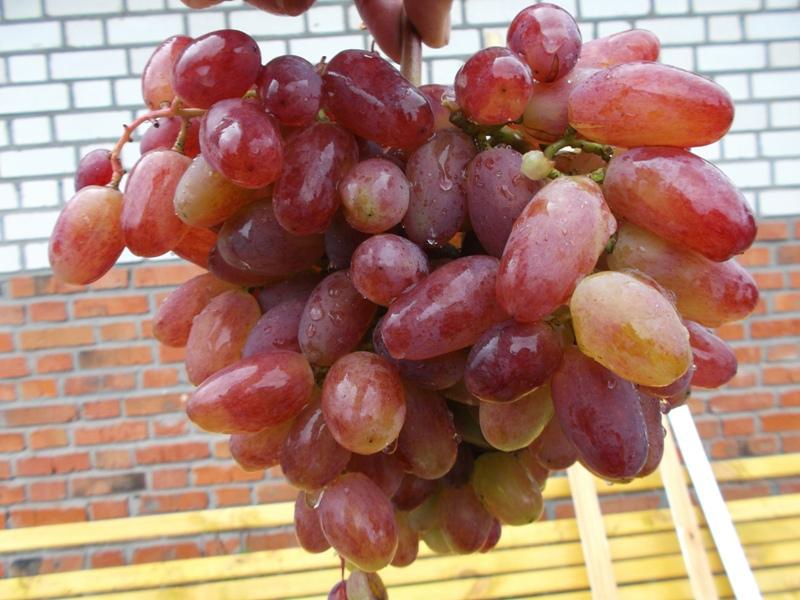
“Julian” is a table grape with beautiful pink berries. Bred V.U. Kapelyushin. As a material for the new variety, the breeder used the cultures “Rizamat” and “Keshu”. Grapes are hybrid, which allows you to stand out qualitatively among varietal plants. To be grown in the southern regions and in the middle zone of Russia.
Content
Characteristics of berry culture
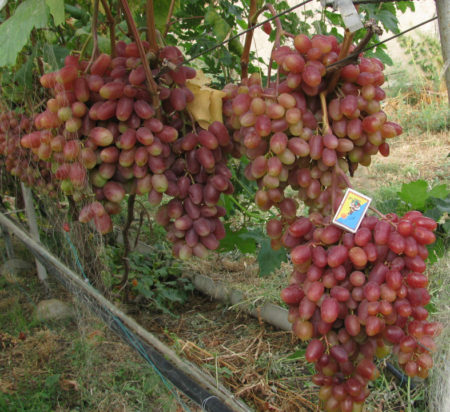
The variety is ultra early ripe. The vegetation cycle is 95-105 days. Berries ripen by early August. The plant is self-pollinated, as the flowers are bisexual. Rainy weather does not affect crop yields. Frost resistance is high. Grapes can withstand temperatures down to -25 ° C. The variety is table, so its main purpose is fresh consumption. Berries are processed for juice and wine.
The fruits are practically not susceptible to irrigation. Medium resistance to fungal diseases; preventive spraying is required. It is established that the plant is little exposed to mildew and oidium. Productivity from one adult bush is 30 kilograms. With proper care, winegrowers managed to collect 50-60 kilograms of fruit.
Description of the appearance of grapes
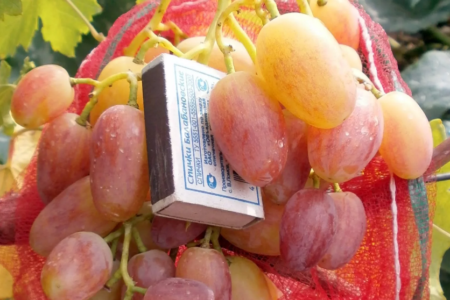
Bushes are medium-sized. Leaves are rounded heart shaped. Shoots are strong, ripen along almost the entire length. The load on the bush is 40-45 eyes. Brushes are tied large, but not dense. The mass of one bunch reaches 0.7-2 kilograms. The brush practically does not hold its shape; it looks like a cone. The root system is strong, takes root quickly.
The berries are oval-elongated, pointed at the end. The weight of one reaches 15-20 grams. The skin is thin, painted pink with yellow stripes. In the southern regions, due to the abundance of sunlight, the berries acquire a lilac hue. The pulp is juicy and dense. When cracked, a crunch is created. The taste is pleasant, tasters note a strawberry flavor and a pleasant nutmeg aroma. At high humidity, the fruits do not crack. Firmly attached to the twig. Perfectly transfers transportation over long distances.
Advantages and disadvantages
"Julian" inherited from parents, both advantages and disadvantages. The advantages of the plant are:
- short growing season;
- high resistance to the most common fungal diseases;
- commodity appearance;
- wonderful aroma and taste;
- high resistance of vines and buds to frost;
- stable yield;
- self-pollination.
Disadvantages:
- you need to select a sunny and calm place;
- Despite frost resistance, it requires shelter for the winter.
Agricultural technology
Land grapes in spring, so he will have the opportunity to take root well in order to survive the winter more easily. Give preference to seedlings in containers.
Landing
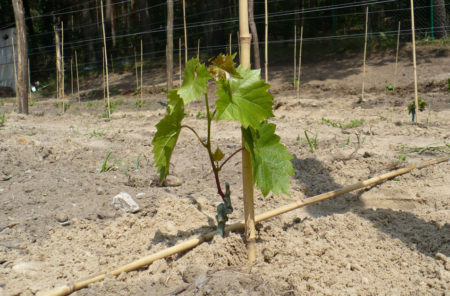
Choose a sunny place on the site without drafts. Do not place the berry culture too close to tall trees. The root system of the plant is growing rapidly, it needs space for growth. And large trees can "clog" the development of grapes.
Spring planting involves autumn soil preparation. "Julian" loves neutral or slightly acidic soil. During the preliminary preparation of the pit, if the soil is acidified, add slaked lime in the autumn. Consumption per square meter is one glass. To make the soil nutritious by spring, add rotted manure (one bucket) and mineral fertilizers (superphosphate 50 grams and potassium sulfate 40 grams) to the extracted soil. In cases where the earth is clay, the application of sand will make it loose (1 bucket per 1 m²). The size of the pit should be 90 centimeters in depth and 80 centimeters in width.
Plant seedlings when the air temperature in the street warms up to at least + 10-12 ° C. Dig a hole that has been fertilized since the fall, lay a layer of drainage on the bottom so that the water does not stagnate at the root system. Place the seedling, cover it with fertile soil, compacting it. Complete planting by irrigation. Pour 30 liters of water under the bush.
Cultivation and care
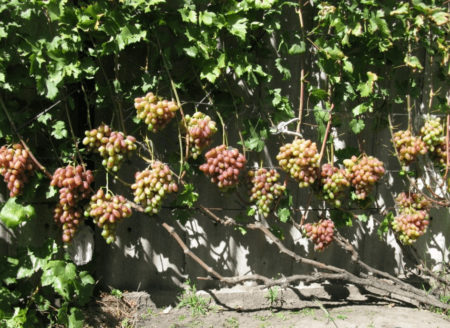
The early ripe Julian does not require special care. You should adhere to the basic rules for growing, and then the crop will be plentiful and timely:
- Watering. Berry culture does not like very waterlogged soil. Water once every two weeks using 20-30 liters of water. It is recommended that 7 days before the expected flowering, irrigation with the addition of 0.5 kg of wood ash. During flowering and ripening, do not water the plant.
- Fertilizer. In the spring, under the bush, apply mineral fertilizers. Prepare liquid top dressing based on 20 grams of urea, 30 grams of Kalimagnesia, 30 grams of superphosphate and 10 liters of water. Pour the resulting fluid over the borehole. In the autumn, spread organic fertilizers under the bushes. Use compost or humus. For one square meter, you need somewhere a bucket of organics.
- Pruning bushes. Form the plant in early spring. At least 40-45 eyes should remain on the shrub. In cases when the berries begin to grow smaller, perform additional pruning in summer so that all the forces of the plant go to the formation of large fruits, rather than the development of green mass.
- Disease Prevention Spring spraying with fungicides will prevent the spread of ailments. For prophylaxis, use Bordeaux liquid or solutions based on the preparations "Khom", "Topaz".
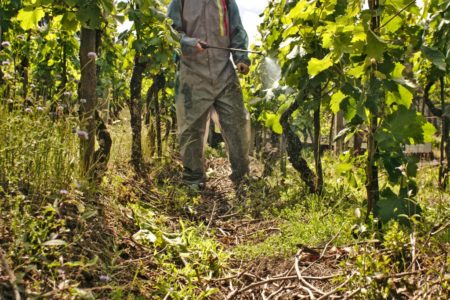
- Preparing for the winter. Remove the vine from the arches, gently tilt it to the ground, tie it into bundles and cover. As a shelter material, use an embankment from the ground, a film of straw, or leaves with a ruberoid.
Reviews of winegrowers
Gardeners in the southern regions of Russia appreciate grape "Julian". It attracts with its resistance to disease, high palatability, large-fruited and other virtues. Sweet berries become easy prey for birds. To protect them from the invasion of birds, winegrowers recommend tightening the bunches with a fine mesh during the period of technical ripeness. It is necessary to tightly tighten her hands, lead her so that she hangs slightly, thereby preventing the birds from picking berries.

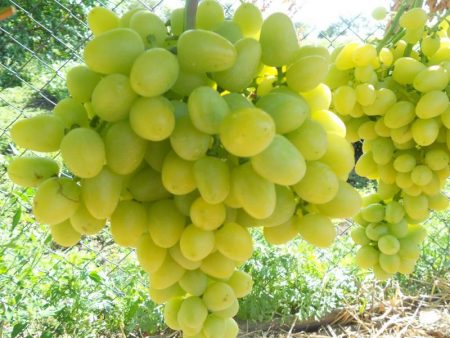



 Non-covering winter-hardy grape varieties for Moscow region
Non-covering winter-hardy grape varieties for Moscow region How to keep the vine in winter
How to keep the vine in winter When can I transfer grapes to another place in the fall
When can I transfer grapes to another place in the fall How to cover and prepare grapes for the winter in the suburbs
How to cover and prepare grapes for the winter in the suburbs